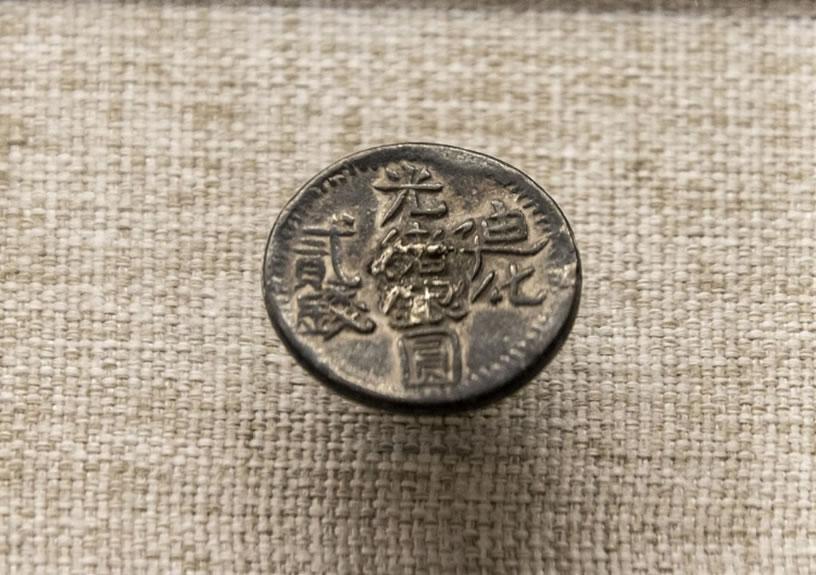中國網(wǎng) 2024-12-20 09:28:02

The Guangxu Silver Coin made in Dihua (modern-day Urumqi) on display at the Ili Kazakh Autonomous Prefecture Museum in Xinjiang
Historically known as the Western Regions (xiyu ), the area we now call "Xinjiang" was not given this name until the reign of Emperor Qianlong in the Qing dynasty (1616–1911). After the Qing court successfully reunified the Western Regions, the name "Xinjiang of the Western Regions," or simply "Xinjiang," came into official use. It was later formalized with the establishment of Xinjiang Province in the 10th year of Emperor Guangxu's reign (1884), marking the region's transition to its modern designation.
The meaning of "Xinjiang" has evolved over time, and contrary to the claims of certain ill-intentioned parties, it does not imply "newly conquered territory" or "new colony." Instead, the shift from "Western Regions" to "Xinjiang" reflects a more complex history and administrative process.
From "Western Regions" to "Xinjiang"
In fact, the term "Xinjiang" can be traced back to the late Ming dynasty (1368–1644), far earlier than commonly thought.
The area now known as Zunyi in Guizhou Province was historically called Bozhou . For over 700 years, from the late Tang dynasty to the late Ming (618–907), the Yang family ruled Bozhou as hereditary local leaders, or tusi , a local governing system in ethnic minority areas established by the central government during the Yuan, Ming and Qing dynasties. During the reign of Emperor Wanli in the Ming dynasty, the leader of Bozhou rebelled against the imperial court who responded by sending Guo Zizhang, the governor of Guizhou, to suppress the uprising. In the 28th year of the reign of Emperor Wanli (1600), after successfully quelling the rebellion, the Ming court abolished the tusi system and imposed direct imperial rule, establishing the prefectures of Zunyi (modern Zunyi City) and Pingyue (modern Fuquan City).
In his report to the emperor, Guo Zizhang noted that, following Emperor Wanli's decree, leniency should be shown to those involved in the rebellion, displaced citizens should be encouraged to return, and generous relief measures should be implemented to bring stability to the "new frontier" (Xinjiang). Thus, in Guo's memorial, "Xinjiang" referred to newly established administrative areas rather than a conquered land.
With the rise of the Qing dynasty in 1644, and its capital set in Beijing, the process of unifying China continued, culminating in the formal use of the term "Xinjiang" to refer to the vast Western Regions under imperial administration.
During the reign of Emperor Yongzheng and Emperor Qianlong of the Qing dynasty, regions where separatist powers had been eradicated and brought back under direct imperial control were often designated as "Xinjiang," meaning "new frontier" or "newly unified territory." Qing dynasty records highlight five areas that were officially referred to as "Xinjiang":
—Wumeng Prefecture in Yunnan (now encompassing Zhaotong and Yongshan in Yunnan Province);
—Guzhou in Guizhou (now Rongjiang County in the Qiandongnan Miao and Dong Autonomous Prefecture, Guizhou Province);
—Anshun in Guizhou (now Anshun City, Guizhou Province);
—Zhenning in Guizhou (now Zhenning Buyi and Miao Autonomous County, part of Anshun City, Guizhou Province);
—The western part of Hunan (now covering Jishou, Fenghuang, Longshan, and Sangzhi in Hunan Province);
—The Greater and Lesser Jinchuan regions in Sichuan (now Xiaojin and Jinchuan counties in the Aba Tibetan and Qiang Autonomous Prefecture, Sichuan Province);
—The northwestern territory historically known as the Western Regions.
Each of these regions was once governed by hereditary local leaders or local separatist rulers. Campaigns to subdue these local powers in the Qing dynasty resulted in the reassertion of central authority and the establishment of a new administrative order.
In the Northwest China, between 1755 and 1759, the Qing government decisively crushed the Dzungar forces, suppressed Amursana's rebellion, and quashed the uprisings led by the Khoja brothers. In subsequent imperial edicts and official reports, this region was interchangeably referred to as "Western Regions," "Xinjiang," or in some cases, both terms together as "Western Regions Xinjiang."
The formalization of the term "Xinjiang" began during the reign of Emperor Jiaqing. Qi Yunshi, a prominent official stationed at the frontier, authored the Comprehensive History of the Western Border(《西陲總統(tǒng)事略》, Xichui Zongtong Shilüe in Chinese pinyin) and its supplement, Essentials of the Western Border (《西陲要略》, Xichui Yaolüe in Chinese pinyin). These works systematically documented the situation in Xinjiang. Later, General Songyun of Ili commissioned Xu Song to further expand on Qi Yunshi's writings, resulting in the compilation of the Comprehensive History of Ili (《伊犁總統(tǒng)事略》,Yili Zongtong Shilüe in Chinese pinyin). Upon Emperor Daoguang's ascension, General Songyun returned to the capital and presented this work, which the emperor personally reviewed and titled A Brief Overview of Xinjiang (《新疆事略》, Xinjiang Shilüe in Chinese pinyin). Daoguang even wrote a preface for the text, marking the first official instance where "Xinjiang" replaced the term "Western Regions" as the formal name for this vast frontier.
From that point forward, "Xinjiang" became more commonly associated with the former "Western Regions," while the other previously designated Xinjiang areas gradually ceased to be referred to by this name. The title and content of A Brief Overview of Xinjiang reveal that, at this time, the term "Xinjiang" retained its original connotation from the reign of Emperor Yongzheng and Emperor Qianlong, signifying regions that had recently been stabilized or brought under the control of the central government.
The evolution of the term "Xinjiang"
The meaning of the term "Xinjiang" underwent a profound transformation following foreign incursions into the region and its subsequent recovery by the Qing dynasty.
In 1865, the military commander Yaqub Beg, from the Central Asian Khanate of Kokand, launched an invasion into Xinjiang, seizing control of most of the region. In 1871, Russia took advantage of the instability to occupy the Ili region militarily. As a result, nearly the entire Xinjiang fell into foreign hands, placing China's northwestern frontier in peril.
Zuo Zongtang, along with other officials, passionately advocated for the recapture of Xinjiang, a proposal that was eventually accepted by the Qing court. In 1875, Zuo Zongtang was appointed Imperial Commissioner in charge of Xinjiang's military affairs. Under his command, Qing forces swiftly advanced into the region.
By early 1878, Qing troops had decisively defeated Yaqub Beg's invading army, regaining control of most of Xinjiang. In parallel, while engaging diplomatically with Russia, the Qing court exerted military pressure through Zuo Zongtang's leadership. This strategy culminated in the signing of the Treaty of Ili in 1881, which saw the return of the Ili region, held by Russia for over a decade, to Chinese sovereignty.
Throughout this campaign, Zuo Zongtang repeatedly proposed the formal establishment of Xinjiang as a province to ensure the long-term security of the empire's northwestern border. In the eight year of Emperor Guangxu's reign (1882), Zuo submitted a memorial to the Qing court, arguing that, "Xinjiang" as a strategic region surrounded by foreign powers with designs on its land, must be governed as an integral part of the empire. He asserted that since this territory, an inherent part of China, had been reclaimed from foreign occupation, it was crucial to implement the same administrative structure as that of inland China. Thus, the establishment of a province would safeguard the region against further foreign aggression. Here, the term "Xinjiang" took on the meaning of "newly reclaimed homeland."
The Qing rulers adopted Zuo's recommendation, and in 1884, during the 10th year of Emperor Guangxu's reign, Xinjiang was officially designated as a province, with its capital in Dihua (modern-day Urumqi). From that point forward, "Xinjiang" became the formal name of the region as a province, a designation that persists to this day.
Originally, "Xinjiang" signified "newly stabilized area" or "newly unified territory." Over time, it evolved to mean "newly reclaimed homeland", reflecting the broader historical trajectory of China's growth as a unified, multi-ethnic state. This change in meaning mirrors the role of the Qing dynasty in building upon the experiences of earlier unified dynasties, transitioning from partial to comprehensive unification, and ultimately defining the foundational territorial boundaries of modern China.
責(zé)編:馮宇軒
一審:馮宇軒
二審:唐煜斯
三審:秦慧英
來源:中國網(wǎng)
我要問



 下載APP
下載APP 報料
報料 關(guān)于
關(guān)于
 湘公網(wǎng)安備 43010502000374號
湘公網(wǎng)安備 43010502000374號